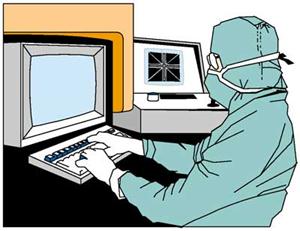System administrator
A system administrator (sysadmin), is a person employed to maintain and operate a computer system and/or network.
Sysadmins are usually charged with installing, supporting, and maintaining servers or other computer systems. Other duties may include scripting or light programming.
Perhaps the most important skill for a system administrator is problem solving -- frequently under various sorts of constraints and stress. The sysadmin is on call when a computer system goes down or malfunctions, and must be able to quickly and correctly diagnose what is wrong and how best to fix it.  System administrators are not software engineers or developers. However, sysadmins must understand the behavior of software in order to deploy it and to troubleshoot problems, and generally know several programming languages used for scripting or automation of routine tasks.
System administrators are not software engineers or developers. However, sysadmins must understand the behavior of software in order to deploy it and to troubleshoot problems, and generally know several programming languages used for scripting or automation of routine tasks.
When dealing with Internet-facing or business-critical systems, a sysadmin must have a strong grasp of computer security.
Many organizations staff other jobs related to systems administration.
A database administrator (DBA) maintains a database system, and is responsible for the integrity of the data and the efficiency and performance of the system.
A network administrator maintains network infrastructure such as switches and routers, and diagnoses problems with these or with the behavior of network-attached computers.
A security administrator is a specialist in computer and network security, including the administration of security devices such as firewalls, as well as consulting on general security measures.
A web administrator maintains web server services (such as Apache or IIS) that allow for internal or external access to web sites. Tasks include managing multiple sites, administering security, and configuring necessary components and software. Responsibilities may also include software change management.
Technical support staff responds to individual users' difficulties with computer systems, provide instructions and sometimes training, and diagnose and solve common problems.
A computer operator performs routine maintenance and upkeep, such as changing backup tapes or replacing failed drives in a RAID.
 A postmaster is the administrator of a mail server.
A postmaster is the administrator of a mail server.
In some organizations, a person may begin as a member of technical support staff or a computer operator, then gain experience on the job to be promoted to a sysadmin position.
Unlike many other professions, there is no single path to becoming a system administrator. Many system administrators have a degree in a related field: computer science, information technology, computer engineering,, or even a trade school program. In addition, because of the practical nature of systems administration and the easy availability of open-source server software, many systems administrators enter the field self-taught.
I. Translate the following words:
1) malfunction 2) to deploy 3) to troubleshoot 4) behavior 5) grasp 6) to staff 7) to respond 8) maintenance 9) upkeep 10) to promote.
II. Translate the word combinations and find them in the text:
1) компьютер, подключенный к сети 2) сетевая безопасность 3) меры безопасности 4) магнитные ленты для резервного копирования данных 5) профессионально-техническое училище (лицей) 6) самоучка ● 1) комп'ютер, підключений до мережі 2) мережева безпека 3) заходи безпеки 4) магнітні стрічки для резервного копіювання даних 5) професійно-технічне училище (ліцей) 6) самоук.
III. Make ten questions of different types to the text.
IV. Make a detailed plan for the retelling of the text.
V Give the full name of the shortenings and explain the meaning:
IIS; RAID